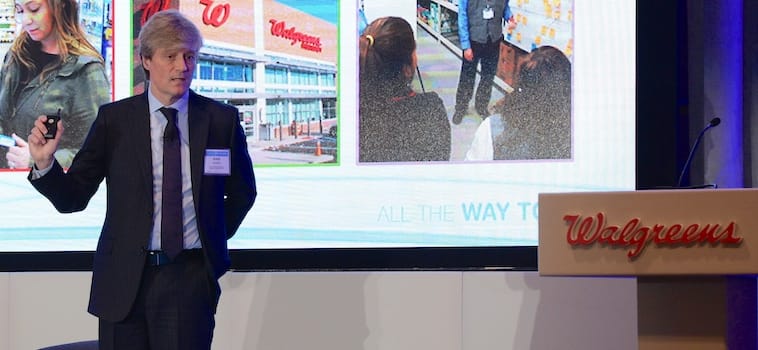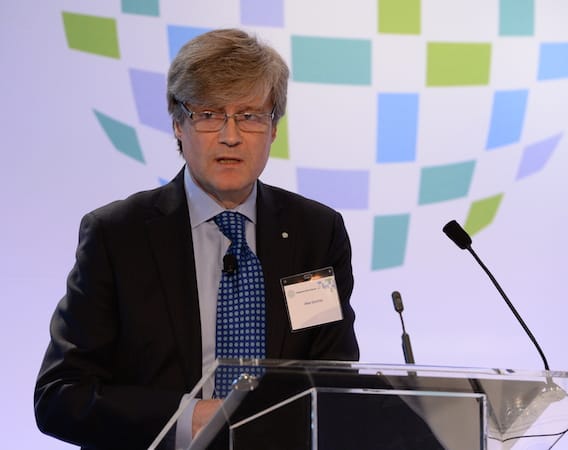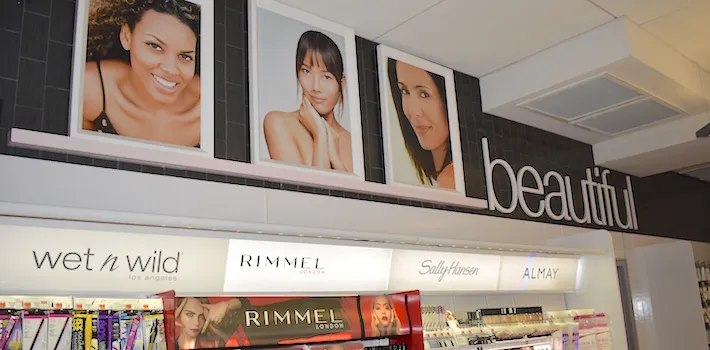
Alex Gourlay: “I really do believe pharmacies, including Walgreens, are the best retail network.”
DEERFIELD, Ill. — To the casual observer, the dominant story line at Walgreens might appear to be the phased acquisition of 1,932 drug stores and related assets from Rite Aid Corp., and plans for their subsequent assimilation. But, important as the deal is, it shouldn’t be allowed to obscure other compelling developments at Walgreens Boots Alliance’s flagship chain.
Ambitious initiatives are under way across the business — including efforts to fortify prescription drug market share, make the stores a destination for beauty shoppers and revamp technological capabilities — that will help shape Walgreens’ future in the health care and retail sectors.
“The reason Walgreens has been around since 1901 is it’s an innovative company,” says Alex Gourlay, who, along with Ornella Barra, is co-chief operating officer of WBA. “We’ve always been at our best and perform best when we’re innovating. Right now we’re in an innovation phase again and that’s very, very exciting. Our primary focus is on the development of even better customer solutions and data solutions. Walgreens has always found a way to stay relevant. We’re doing that for a new generation.”
For his contributions to the emergence of a renewed sense of purpose and embrace of new thinking at the company, the editors of Chain Drug Review have chosen Gourlay for the publication’s Retailer of the Year Award.
The retail empire that Gourlay runs for WBA, which includes Boots, the No. 1 drug chain in the United Kingdom, as well as Walgreens, will grow considerably as the Rite Aid stores are brought into the fold. An 18-month program to rationalize the expanded store base, entailing the closure of some 600 locations, will accompany the $4.375 billion purchase.

“The Rite Aid acquisition was always designed to give us a fuller network across America by filling in some of the gaps in our current network. While it doesn’t fill every gap, the new deal is a good step forward,” says Gourlay, alluding to the fact that WBA had originally intended to buy the entire Rite Aid chain, but scaled back its plans in the face of opposition from the Federal Trade Commission.
“We get stores in the Northeast, we get stores in the South. We don’t get what we wanted in the West, so that will take more time and be a different strategy. But we still are strengthening our network considerably, and on top of that we’re getting some talented people.”
With the addition of the Rite Aid outlets, Walgreens’ store base will approach 9,500, buttressing an important asset in the competition for third-party pharmacy contracts. The expanded coverage should enable the drug chain to build on the considerable success it has had in recent years in winning back prescription drug market share after a dispute with Express Scripts six years ago caused it to temporarily lose access to the patients handled by the pharmacy benefits management company.
Partnerships with PBMs and other health care stakeholders have helped Walgreens expand its pharmacy share beyond the level it was prior to the clash with Express Scripts. The agreement with OptumRx, UnitedHealth Group’s PBM, is a case in point. Designed to deliver a more convenient, accessible and connected pharmacy experience, the deal covers such areas as 90-day scripts, medication adherence and health care analytics.
“We’ve succeeded through partnerships and listening to what our partners want and matching that up with our capabilities,” notes Gourlay, who was trained as a pharmacist in the U.K. and rose through the ranks at Boots before moving to Walgreens four years ago. “Of course it’s about price, but more important it’s about customer value. That’s clearly worked for us.”
Specialty pharmacy is another area where Walgreens has benefited by innovating. Together with PBM Prime Therapeutics, the drug chain last year formed AllianceRx Walgreens Prime, a centrally managed specialty pharmacy and mail service provider. In addition, Walgreens has launched specialized pharmacies focused on such disease states as oncology, hepatitis and HIV.
“We’ve created more of a unique model in which centralized service complements our community pharmacies where we’re also dispensing these medications,” Gourlay says. “We believe that a mix of centralized and local pharmacies is best for patients who are receiving some of the most complicated and expensive medications. We’re providing them the option of support from their local pharmacist in their community, and that’s critical as specialty medications grow to 50% of the dollar value of pharmacy by 2020.
“As someone who grew up in retail pharmacy, giving patients the option of getting their medications at their local pharmacy is important. I think as patients and the health care industry see the benefits from this approach it can potentially create a bend in the cost curve for specialty medications, and that’s positive for the market overall.”

Gourlay: “We’ve got to go where the customer is going.”
The dynamism in Walgreens’ pharmacy operations is also evident at the front end. With an emphasis on health and beauty care, the products and services available inside the store are being rethought in light of changing consumer preferences.
“Fundamentally, we’re customer led, so we’re constantly using the data we gather and the insights we gather from customers to think about where are we taking the model,” notes Gourlay. “We also want to surprise them sometimes with things they don’t expect to get from a drug store, very similar to what Amazon does.
“Our new partnership with FedEx is a good example of that. The ability to collect and drop off parcels and products from other marketplaces at more than 7,500 Walgreens locations will please and surprise a lot of customers. It demonstrates the quality of our last-mile proposition.
“I really do believe pharmacies, including Walgreens, are the best retail network. People will be pleasantly surprised by how other partners in the supply chain, for both Walgreens and for FedEx, use that opportunity.”
Beauty care is a focal point for the ongoing transformation at Walgreens. As part of a long-term effort to establish itself as a beauty destination, the drug chain has upgraded the presentation and product mix, including the introduction of such WBA-owned brands as No7, Botanics and Soap & Glory, and added trained beauty consultants to some 3,000 stores.
“Momentum is everything in life, as we all know, and we have momentum,” Gourlay assets. “We’re not short of cash as a company, and we’ll continue to invest in the category, but you can’t waste resources and you can’t get too anxious.
“We’ve got to go where the customer is going in a market that’s changing. Digital technology, mobile apps, influencers are things that are very important in today’s market that weren’t there five years ago when we contemplated this journey.”
One powerful tool Walgreens can draw on to shape its offerings in beauty and other departments is Balance Rewards. With 88 million active members, the customer loyalty program continuously generates data that reflects where consumers are and where they are headed.
“We’re using the information to curate the store shelves,” says Gourlay, citing as an example the recent streamlining of the product mix in approximately 1,500 Walgreens stores to make shopping easier and more convenient. “In the simplified stores that we rolled out this summer we took 20% of the SKUs off the shelf. We were able to do that because we used the data on what people buy in the stores locally. We’ve been able to demonstrate again that data really helps curate properly for cost margin without inconveniencing customers.
“Then we go to the other side of it and how do you personalize in the world of digital, and talk to customers that want to talk to you, give you their email, give you the ability to text them. How do you talk to them personally? Again, we’re leveraging that through all of the digital channels that we have.”
Omnichannel retail and technology are central to the retailer’s strategy. In addition to cultivating the growth of its e-commerce business, which 18 months ago was consolidated under the walgreens.com banner, and utilizing the full range of digital media to communicate with consumers, the drug chain is rebuilding its in-house systems. Going forward, its Rx Renewal program will develop a system to supplant Intercom Plus as Walgreens’ proprietary pharmacy technology package, while Retail Transformation, based on SAP Hana S4 technology, will drive front-end operations.
“Rx Renewal, which is being tested in a couple pharmacies today, will bring together a number of inputs that the patient requires, either from the doctor or from the insurer, and enable the pharmacist to access them in one place,” Gourlay explains. “By running through different screens, the pharmacist will have all the relevant information, including if a patient has a condition that requires special attention and the best way to receive these medications from a cost point of view, to deliver the best possible patient care. Rx Renewal will empower patients to take care of their own health in different ways, and give the pharmacist greater understanding of who the patient is and what’s in front of them.
“Retail Transformation will provide real-time information about where stock is in the supply chain and take a lot of the workload away from the stores. It will change Walgreens for the better, by making us more efficient and freeing up store personnel to spend more time with customers at the front end.”
While Gourlay acknowledges the impact of Amazon and other e-commerce companies on mass market retailing, and understands that traditional merchants must adapt to new perceptions of convenience among consumers, he expresses confidence about the future of Walgreens, Boots and WBA’s other brick-and-mortar stores: “We love shops and, more importantly, our customers love shops because they love our pharmacists. They love the human contact.
“The whole future of our stores has been based on backing up our people with great capability. We understand that very well, and it’s a critical part of our model. The human contact is what makes us different. The only place you find human contact in the flesh is usually in shops.”
Gourlay and his colleagues have set out to update Walgreens’ brand identity to reflect the mix of tradition and innovation that has come to characterize the drug chain. Bearing the tagline “Trusted since 1901,” a campaign to introduce the new Walgreens emphasizes the constants that connect the retailer’s past and future.
“We went deep into Walgreens’ history to rediscover what makes Walgreens great,” Gourlay says. “It was clear from our research that three strong characteristics, rooted firmly in our history, define our relationship with our customers — care, trust and accessibility. We’ve always cared for our customers’ health and well-being, but how we’ve cared has evolved over time. As consumer behavior continues to change, we will focus on these core attributes to help define the work we do.”







